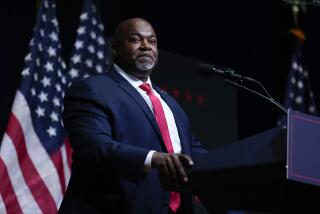Politickers Go After Hearts, Minds of Midsection’s Voters
- Share via
PLANT CITY, Fla. — Dan Snyder once was the most wanted man in America. He was an undecided voter.
As Vice President Al Gore, Texas Gov. George W. Bush and their campaign surrogates flitted in and out of the battleground state of Florida last week, Snyder was applying adhesive lettering to the storefront window of a soon-to-open downtown gun shop and explaining how he finally made up his mind on who gets his vote in Tuesday’s presidential election.
“As a business owner,” said Snyder, 57, whose company is called Effective Signs and Advertising, “I probably should be for the Republicans. But I don’t want a Republican-controlled Congress and a president of the same party. So, if I had to vote for either Bush or Gore, I’d vote for Gore.”
But ultimately--and here’s where it gets tricky--Snyder decided not to vote for either major party candidate. He plans to cast his ballot for Libertarian Harry Browne as a protest of what he calls the dishonesty of politics. In the end, he said, “the candidates say whatever it takes to win and not what they mean.”
Snyder’s vote may be lost to Democratic nominee Gore and Republican hopeful Bush, but there are others still up for grabs here along what is called the I-4 corridor, the 140-mile ribbon of interstate highway that runs from Daytona Beach on the East Coast to Tampa on the Gulf of Mexico. Whoever wins the corridor vote wins Florida and its 25 electoral votes, Democratic and GOP strategists agree.
Statewide polls say the contest for Florida remains a dead heat. President Clinton narrowly carried the state in 1996, but the candidate’s younger brother, Florida Gov. Jeb Bush, has been a more active campaigner lately, and Jeb Bush’s approval rating is high.
The shorthand reading on Florida is that the Republicans’ strength lies with Cuban Americans in Miami, military retirees and residents of northern Florida, which resembles neighboring Georgia in geography and culture. The Democrats traditionally have relied on women, non-Cuban Latinos and retirees with liberal leanings, many of them Jewish, who live along the Gold Coast from Miami to Palm Beach.
That leaves the state’s midsection as ground zero for last-minute politicking.
How to appeal to voters here, however, remains somewhat of a mystery.
Plant City, an agricultural center 25 miles east of Tampa, is what Florida State University political scientist Lance de Haven-Smith calls “a marble cake,” layered with different ethnic, economic and age groups. In the mix here are retirees, white-collar commuters with office jobs in Tampa, small-factory workers, big farmers who have made this town of 27,000 the state’s strawberry capital, and Latinos--many of them Mexican American--who came here originally to toil in the fields.
This area is also home to many Reagan Democrats, who plan to stay outside the Democratic fold to back Bush.
“I don’t think either party gives the voters enough credit for being smart,” said Jerry Lofstrom, 55, who moved here from Minnesota 20 years ago and now owns a downtown cafe, The Whistle Stop. “I’m going to vote for Bush chiefly because I don’t like Gore.”
Lofstrom’s brother John, 57, who retired from his Minnesota factory job and moved south a year ago, says the Texas governor probably will get his vote too, although he had reservations that a change in administration might hurt the economy. And both men say they have conquered doubts about the candidate’s intellectual capacity by agreeing that Bush would, in Jerry’s words, “surround himself with sharp people.”
Some of Gore’s support in this area is expected to come from Mexican American voters, including at least 400 who have become citizens in the last four years with the help of workshops run by the Redlands Christian Migrant Assn.
“People felt left out in the last election, so we’ve made a real effort to get people registered,” said area coordinator Lourdes Villanueva.
The Democrats’ positions on health care and education are favored by the majority of Latino voters here, Villanueva said. But, she cautioned, Bush could get some support too.
“We’ve been surprised at all the attention we are getting from the candidates,” said Villanueva, who added that it is silly for Gore and Bush to think they can win Latino votes by uttering a few words in Spanish. “I think most people think they should forget the Spanish and just concentrate on doing the right thing.”
At this late date, De Haven-Smith and Susan MacManus, a political scientist at the University of South Florida, concur that the candidates’ main focus here is to shore up traditional blocs of support even as they woo lingering undecideds.
“The GOP voters are steady; they are better off and will go to the polls,” said De Haven-Smith. “But the Democrats have to work to turn that base out. They can show or not show.”
And he doubts there are many yet-undecided votes to harvest, even here. “The only ones left are the veteran informed, the people who are still reading the fine print of the platforms,” De Haven-Smith said, “and the ones who are just not going to vote.”
MacManus put it this way: “This state is not undecided; it’s divided. And at this point, I think people have tuned out. Florida voters have been in the front row for so long, and been courted by the candidates so much, that the thrill is gone.”
*
Times researcher Anna M. Virtue contributed to this story.
More to Read
Get the L.A. Times Politics newsletter
Deeply reported insights into legislation, politics and policy from Sacramento, Washington and beyond. In your inbox twice per week.
You may occasionally receive promotional content from the Los Angeles Times.










